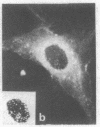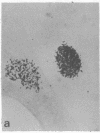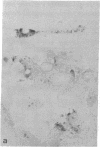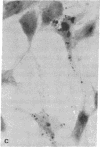Abstract
The peroxidase and immunofluorescent localization patterns of androgen-binding protein (ABP), a biological marker of Sertoli cell function, have been examined in cultured Sertoli cells isolated from 20- to 22-day-old rats. ABP immunoreactivity in the form of cytoplasmic granules of variable diameter was observed in Sertoli cells with characteristic lipid droplets and a colony-forming, epithelial-like growth pattern. Incubation of cultures with [3H]thymidine demonstrated that Sertoli cells continue to produce ABP while retaining their capability for synthesizing DNA and undergoing mitosis. A variable number of cultured Sertoli cells became morphologically transformed after exposure to follitropin (follicle-stimulating hormone) and pharmacological agents acting on cyclic nucleotide metabolism. The induced change in Sertoli cell shape coincided with a disappearance of ABP-containing granules from the cytoplasm. These observations demonstrate that localization of ABP by immunological techniques is a valuable tool for the characterization of structural and functional properties of Sertoli cell in culture.
Full text
PDF




Images in this article
Selected References
These references are in PubMed. This may not be the complete list of references from this article.
- Danzo B. J., Cooper T. G., Orgebin-Crist M. C. Androgen binding protein (ABP) in fluids collected from the rete testis and cauda epididymidis of sexually mature and immature rabbits and observations on morphological changes in the epididymis following ligation of the ductuli efferentes. Biol Reprod. 1977 Aug;17(1):64–77. doi: 10.1095/biolreprod17.1.64. [DOI] [PubMed] [Google Scholar]
- Davis J. C., Schuetz A. W. Purification of "colony-forming" cells from immature rat testis. Exp Cell Res. 1977 May;106(2):253–260. doi: 10.1016/0014-4827(77)90170-7. [DOI] [PubMed] [Google Scholar]
- Dorrington J. H., Fritz I. B. Cellular localization of 5alpha-reductase and 3alpha-hydroxysteroid dehydrogenase in the seminiferous tubule of the rat testis. Endocrinology. 1975 Apr;96(4):897–889. doi: 10.1210/endo-96-4-879. [DOI] [PubMed] [Google Scholar]
- French F. S., Ritzén E. M. A high-affinity androgen-binding protein (ABP) in rat testis: evidence for secretion into efferent duct fluid and absorption by epididymis. Endocrinology. 1973 Jul;93(1):88–95. doi: 10.1210/endo-93-1-88. [DOI] [PubMed] [Google Scholar]
- Fritz I. B., Rommerts F. G., Louis B. G., Dorrington J. H. Regulation by FSH and dibutyryl cyclic AMP of the formation of androgen-binding protein in Sertoli cell-enriched cultures. J Reprod Fertil. 1976 Jan;46(1):17–24. doi: 10.1530/jrf.0.0460017. [DOI] [PubMed] [Google Scholar]
- GREENWOOD F. C., HUNTER W. M., GLOVER J. S. THE PREPARATION OF I-131-LABELLED HUMAN GROWTH HORMONE OF HIGH SPECIFIC RADIOACTIVITY. Biochem J. 1963 Oct;89:114–123. doi: 10.1042/bj0890114. [DOI] [PMC free article] [PubMed] [Google Scholar]
- Griswold M. D., Mably E. R., Fritz I. B. FSH stimulation of DNA synthesis in Sertoli cells in culture. Mol Cell Endocrinol. 1976 Feb;4(3):139–149. doi: 10.1016/0303-7207(76)90033-2. [DOI] [PubMed] [Google Scholar]
- Hansson V., Reusch E., Trygstad O., Torgersen O., Ritzen E. M., French F. S. FSH stimulation of testicular androgen binding protein. Nat New Biol. 1973 Nov 14;246(150):56–58. doi: 10.1038/newbio246056a0. [DOI] [PubMed] [Google Scholar]
- Heggeness M. H., Wang K., Singer S. J. Intracellular distributions of mechanochemical proteins in cultured fibroblasts. Proc Natl Acad Sci U S A. 1977 Sep;74(9):3883–3887. doi: 10.1073/pnas.74.9.3883. [DOI] [PMC free article] [PubMed] [Google Scholar]
- Hutson J. C. The effects of various hormones on the surface morphology of testicular cells in culture. Am J Anat. 1978 Jan;151(1):55–69. doi: 10.1002/aja.1001510106. [DOI] [PubMed] [Google Scholar]
- Kerr J. B., De Kretser D. M. Cyclic variations in Sertoli cell lipid content throughout the spermatogenic cycle in the rat. J Reprod Fertil. 1975 Apr;43(1):1–8. doi: 10.1530/jrf.0.0430001. [DOI] [PubMed] [Google Scholar]
- Kierszenbaum A. L. RNA synthetic activities of sertoli cells in the mouse testis. Biol Reprod. 1974 Nov;11(4):365–376. doi: 10.1095/biolreprod11.4.365. [DOI] [PubMed] [Google Scholar]
- LAURELL C. B. ANTIGEN-ANTIBODY CROSSED ELECTROPHORESIS. Anal Biochem. 1965 Feb;10:358–361. doi: 10.1016/0003-2697(65)90278-2. [DOI] [PubMed] [Google Scholar]
- Laemmli U. K. Cleavage of structural proteins during the assembly of the head of bacteriophage T4. Nature. 1970 Aug 15;227(5259):680–685. doi: 10.1038/227680a0. [DOI] [PubMed] [Google Scholar]
- Lehnert S. Changes in morphology and cell cycle traverse induced in CHO cells by methyl isobutyl xanthine. Exp Cell Res. 1979 Jul;121(2):383–394. doi: 10.1016/0014-4827(79)90018-1. [DOI] [PubMed] [Google Scholar]
- Louis B. G., Fritz I. B. Stimulation by androgens of the production of androgen binding protein by cultured Sertoli cells. Mol Cell Endocrinol. 1977 Mar;7(1):9–16. doi: 10.1016/0303-7207(77)90071-5. [DOI] [PubMed] [Google Scholar]
- Mather J. P., Sato G. H. The use of hormone-supplemented serum-free media in primary cultures. Exp Cell Res. 1979 Nov;124(1):215–221. doi: 10.1016/0014-4827(79)90271-4. [DOI] [PubMed] [Google Scholar]
- Means A. R., Fakunding J. L., Tindall D. J. Follicle stimulating hormone regulation of protein kinase activity and protein synthesis in testis. Biol Reprod. 1976 Feb;14(1):54–63. doi: 10.1095/biolreprod14.1.54. [DOI] [PubMed] [Google Scholar]
- Musto N. A., Gunsalus G. L., Miljković M., Bardin C. W. A novel affinity column for isolation of androgen binding protein from rat epididymis. Endocr Res Commun. 1977;4(2):147–157. doi: 10.3109/07435807709073919. [DOI] [PubMed] [Google Scholar]
- Nagy F. Cell division kinetics and DNA synthesis in the immature sertoli cells of the rat testis. J Reprod Fertil. 1972 Mar;28(3):389–395. doi: 10.1530/jrf.0.0280389. [DOI] [PubMed] [Google Scholar]
- Petrusz P., Sar M., Ordronneau P., DiMeo P. Specificity in immunocytochemical staining. J Histochem Cytochem. 1976 Oct;24(10):1110–1112. doi: 10.1177/24.10.789759. [DOI] [PubMed] [Google Scholar]
- Purvis K., Hansson V. Androgens and androgen-binding protein in the rat epididymis. J Reprod Fertil. 1978 Jan;52(1):59–63. doi: 10.1530/jrf.0.0520059. [DOI] [PubMed] [Google Scholar]
- Ritzén E. M., French F. S., Weddington S. C., Nayfeh S. N., Hansson V. Steroid binding in polyacrylamide gels. Quantitation at steady state conditions. J Biol Chem. 1974 Oct 25;249(20):6597–6604. [PubMed] [Google Scholar]
- Robyn C., L'Hermite M., Petrusz P., Diczfalusy E. Potency estimates of human gonadotrophins by a bioassay and three immuno-assay methods. Acta Endocrinol (Copenh) 1971 Jul;67(3):417–433. doi: 10.1530/acta.0.0670417. [DOI] [PubMed] [Google Scholar]
- Steinberger A., Heindel J. J., Lindsey J. N., Elkington J. S., Sanborn B. M., Steinberger E. Isolation and culture of FSH responsive Sertoli cells. Endocr Res Commun. 1975;2(3):261–272. doi: 10.3109/07435807509053853. [DOI] [PubMed] [Google Scholar]
- Steinberger A., Hintz M., Heindel J. J. Changes in cyclic AMP responses to FSH in isolated rat Sertoli cells during sexual maturation. Biol Reprod. 1978 Oct;19(3):566–572. doi: 10.1095/biolreprod19.3.566. [DOI] [PubMed] [Google Scholar]
- Steinberger A., Steinberger E. Replication pattern of Sertoli cells in maturing rat testis in vivo and in organ culture. Biol Reprod. 1971 Feb;4(1):84–87. doi: 10.1093/biolreprod/4.1.84. [DOI] [PubMed] [Google Scholar]
- Tung P. S., Dorrington J. H., Fritz I. B. Structural changes inducted by follicle-stimulating hormone or dibutyryl cyclic AMP on presumptive Sertoli cells in culture. Proc Natl Acad Sci U S A. 1975 May;72(5):1838–1842. doi: 10.1073/pnas.72.5.1838. [DOI] [PMC free article] [PubMed] [Google Scholar]
- VILAR O., PEREZ DEL CERRO M. I., MANCINI R. E. The Sertoli cell as a "bridge cell" between the basal membrane and the germinal cells. Histochemical and electron microscope observations. Exp Cell Res. 1962 Jun;27:158–161. doi: 10.1016/0014-4827(62)90056-3. [DOI] [PubMed] [Google Scholar]
- Weddington S. C., Hansson V., Ritzen E. M., Hagenas L., French F. S., Nayfeh S. N. Sertoli cell secretory function after hypophysectomy. Nature. 1975 Mar 13;254(5496):145–146. doi: 10.1038/254145a0. [DOI] [PubMed] [Google Scholar]
- Welsh M. J., Wiebe J. P. Rat sertoli cells: a rapid method for obtaining viable cells. Endocrinology. 1975 Mar;96(3):618–624. doi: 10.1210/endo-96-3-618. [DOI] [PubMed] [Google Scholar]











